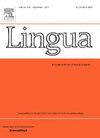The development of copula/affirmative response marker polysemy in Chinese and other languages in China
IF 1.3
3区 文学
0 LANGUAGE & LINGUISTICS
引用次数: 0
Abstract
Contact with Chinese may explain the development of copula/affirmative response marker polysemy in other languages in China. Chinese shì developed the polysemous pattern because it underwent polygrammaticalization in Old Chinese: (a) pronominal demonstrative > demonstrative verb of manner > affirmative response marker, and (b) pronominal demonstrative > copula. Since Middle Chinese, most other usages have disappeared, and the polysemy has persisted for over a millennium. Speakers of other languages in China were in contact with Chinese, and adopted one of the three strategies to incorporate this polysemy: (a) using Chinese shì as a loan word to function as copula and affirmative response marker in the target language, (b) using the copula of the target language to function as affirmative response marker, and (c) using the attributive adjective meaning ‘true, correct’ of the target language to function as copula and affirmative response marker, typically starting with copula. The latter two strategies support two arguments: (a) grammatical changes in language contact do not always involve grammaticalization, and (b) speakers of the target language may sometimes adopt linguistic items with more abstract meaning to refer to more concrete polysemous meaning.
汉语和其他语言中连词/肯定反应标记词多义词的发展
与汉语的接触可以解释中国其他语言中联系词/肯定反应标记词一词多义的发展。汉语shì由于在古汉语中经历了多语法化而发展出多义模式:(a)代词指示动词;(gt)方式指示动词;(gt)肯定反应标记;(b)代词指示连词。自中古汉语以来,大多数其他用法已经消失,而一词多义却持续了一千多年。在中国,说其他语言的人在接触汉语时,采用了三种策略中的一种来吸收这种一词多义:(a)使用汉语shì作为外来词作为目的语的联结词和肯定反应标记;(b)使用目的语的联结词作为肯定反应标记;(c)使用目的语的“真、对”的定语形容词作为联结词和肯定反应标记,通常以联结词开头。后两种策略支持两个论点:(a)语言接触中的语法变化并不总是涉及语法化;(b)目的语使用者有时可能会采用更抽象意义的语言项目来指代更具体的多义。
本文章由计算机程序翻译,如有差异,请以英文原文为准。
求助全文
约1分钟内获得全文
求助全文
来源期刊

Lingua
Multiple-
CiteScore
2.50
自引率
9.10%
发文量
93
审稿时长
24 weeks
期刊介绍:
Lingua publishes papers of any length, if justified, as well as review articles surveying developments in the various fields of linguistics, and occasional discussions. A considerable number of pages in each issue are devoted to critical book reviews. Lingua also publishes Lingua Franca articles consisting of provocative exchanges expressing strong opinions on central topics in linguistics; The Decade In articles which are educational articles offering the nonspecialist linguist an overview of a given area of study; and Taking up the Gauntlet special issues composed of a set number of papers examining one set of data and exploring whose theory offers the most insight with a minimal set of assumptions and a maximum of arguments.
 求助内容:
求助内容: 应助结果提醒方式:
应助结果提醒方式:


